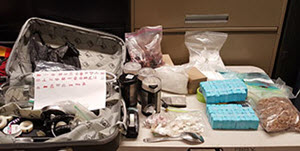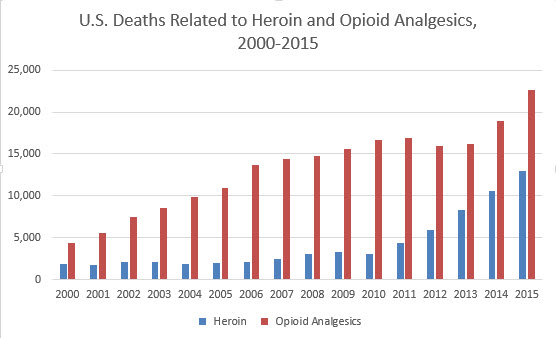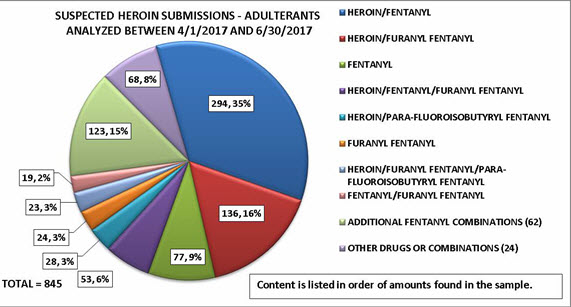According to the Centers for Disease Control and Prevention, there were an estimated 64,000 drug overdose deaths in 2016; where a drug was specified, 76 percent were identified as opioids.[1]
The following provides an overview of illegal opioid drug markets and the National Institute of Justice’s (NIJ’s) efforts to combat drug trafficking, markets, and use of illegal drugs, including licit drug diversion through research and capacity building for law enforcement, forensic laboratories, medical examiners and coroners, prosecutors, and other stakeholders.
Opioid Markets, Use, and Consequences
In June 2016, the U.S. Drug Enforcement Administration (DEA) issued a special National Heroin Threat Assessment. Over a five-year period, heroin seizures increased 143 percent (from 2,763 kilograms in 2010 to 6,722 kilograms in 2015),[2] and forensic lab cases involving heroin increased 70 percent (from 110,393 in 2010 to 187,868 in 2015).[3] State, tribal, and local law enforcement agencies reporting heroin as the greatest drug threat has grown from 8 percent in 2007 to 44 percent in 2017.[4]
Although survey figures indicate a steady increase in heroin use over time (from 314,000 in 2003[5] to 948,000 in 2016), the estimated prevalence of heroin users is low nationwide (0.4 percent in 2016) compared to other drugs.[6] The driving force in opioid markets is prescription drug diversion and illicit synthetic drug production. Second only to marijuana in prevalence, misuse[7] of psychotherapeutic drugs (i.e., pain relievers, tranquilizers, stimulants, or sedatives) in the past year was reported by an estimated 1.3 million Americans (5.3 percent) in 2016. Of these, two-thirds reported misuse of opioid analgesic pain relievers (e.g., hydrocodone, oxycodone, buprenorphine, fentanyl, or methadone).[8]
Increased drug flow, higher potency drugs, and reduced retail prices have led to increased drug use, poisoning, and overdose deaths. Between 2000 and 2015, deaths related to heroin rose by 605 percent to 12,989, and deaths related to opioid analgesics rose by 414 percent to 22,598[9].
Figure generated using Multiple Cause of Death data available on CDC WONDER. View data table.
The overdose figures above include synthetic drugs, also known as novel psychoactive substances (NPS). In September 2016, the DEA issued a warning to the public and law enforcement about the risks of Carfentanil, a synthetic opioid that is many more times potent than heroin or other synthetic drugs like fentanyl or morphine.[10] In addition to these pharmaceuticals that are diverted for nonmedical use, growth in the opioid drug market is fueled by the influx of NPS that are chemically engineered compounds. NPS have a high capacity for rapid development of high-potency analogues, and can be manufactured in clandestine drug labs. Oftentimes, heroin is combined with NPS and other drugs, increasing risk to users who cannot easily identify the drugs. These highly potent drugs and the toxic nature of chemicals used to manufacture NPS make crime and overdose scenes dangerous to first responders who encounter these drugs.[11]
The fast pace of drug product development makes crime scene information collection and analysis difficult for narcotics, forensic science, and medicolegal death investigators. In the aggregate, it presents challenges to drug intelligence and community surveillance agencies to examine trends over regions and time. This delays identification of drug deterrent, interdiction, and organized crime target opportunities. Researchers participating in sentinel community networks report that heroin and other opioids are rapidly climbing in frequency across all drug indicators (drug-involved deaths, drug seizures, treatment admissions, etc.) and regardless of urbanicity or region (e.g., Philadelphia, Maine, and San Francisco).[12]
Drug seizures yield a variety of heroin and other opioids often found in combinations, including fentanyl, analogues (e.g., acetylfentanyl or furanylfentanyl), and other adulterants.
Source: New Jersey Regional Operations & Intelligence Center, April 1, 2016-June 30, 2017. View data table. [13]
NIJ’s Drugs and Crime Research Portfolio
NIJ’s Drugs and Crime Research Portfolio furthers the U.S. Department of Justice’s crime prevention and law enforcement goals by supporting research on violent and other drug-related crime to combat the nation's opioid epidemic and by promoting cost-efficient law enforcement, court, and corrections responses to illegal drug markets (including diversion of prescription drugs) and criminal behavior related to drug use. NIJ remains committed to supporting rigorous basic and applied research on evidence-based tools, protocols, and policies for state, tribal, and local law enforcement and other criminal justice agencies. The current priority is to address drug trafficking, markets, and use that relate to heroin and other opioids such as fentanyl and related analogues.
Controlled Substances and Forensic Toxicology
Under its controlled substances and forensic toxicology research portfolios, NIJ funds research to improve drug recognition and detection for law enforcement, medicolegal death investigation, and offender monitoring. Goals include improving identification, collection, preservation, and analysis of samples; developing more efficient methods to detect drugs; and improving interpretation of findings to better understand drug metabolism and effects on persons. Current grants include research and development projects to identify fentanyl analogues and other NPS.
FY 2012 Research on Illegal Prescription Drug Market Interventions
Collaborations across NIJ science offices have produced research on ways to deter, investigate, and disrupt illegal prescription drug markets:
- Strategies and Resources for High Intensity Drug Trafficking Areas[14]
- Using the North Carolina Controlled Substances Reporting System to Identify Providers Manifesting Unusual Prescribing Practices[15]
- Optimizing Prescription Drug Monitoring Programs (PDMPs) to Support Law Enforcement Activities[16]
- Policy Analysis of Florida House Bill 7095 for Diversion of Psychoactive Prescription Drugs[17]
Learn more about research on illegal prescription drug market interventions.
Drug Recognition and Impairment Research Meeting
Partnering with the National Highway Traffic Safety Administration and the National Institute of Drug Abuse, NIJ led a 2015 meeting on drug recognition and impairment research. The meeting allowed dissemination of information on then-current projects to active practitioners, an exchange of information with other agencies, and an opportunity to solicit feedback. This informs federal plans for future research that are responsive to the field’s information and practice needs. Discussion topics were detection of illegal drugs, including quantitation (purity) of drug seizures; forensic toxicology post-use; reliable measurement of drug impairment; investigative leads for case building; collection and submission of drug evidence for laboratory analysis; tools for drug detection in the field; expert witness/testimony; confirmation of toxicological and chemical analysis; and protocols for prosecution and court case management. This helped lay the foundation for NIJ’s solicitations for applied drugs and crime research. Read a summary of the meeting.
NIJ’s Drugs and Crime Research Solicitations
The NIJ Research and Evaluation on Drugs and Crime FY 2017 (pdf, 41 pages) solicitation requested proposals for research on evidence-based tools, protocols, and policies for state, tribal, and local law enforcement and other criminal justice agencies to better address drug trafficking, markets, and use related to heroin and other opioids, including NPS. (Watch a webinar for details.)
Four grants were awarded:
- An evaluation of a heroin-related drug investigation protocol that guides medical examiners and law enforcement in evidence collection and preservation to improve manslaughter prosecutions of drug dealers. .
- A demonstration of an opioid metric intelligence platform that integrates PDMP and other data for information sharing between law enforcement, medical examiners, and other agencies. View details for award number 2017-IJ-CX-0016.
- A study of heroin and other drug distribution networks in rural and urban counties along interstate highways that combines law enforcement intelligence with community policing for effective interdiction. View details for award number 2017-IJ-CX-0017.
- A data-mining project that examines toxicology results from suspected drug-related death and drug-impaired driving cases in 40 states since 2016, producing time-course trend reports and geographic distribution heat maps that detect emerging patterns of opioids and other drug combinations. View details for award number 2017-DN-BX-0169.
With the Research and Evaluation on Drugs and Crime FY 2018 solicitation, NIJ requested proposals for research on heroin and other opioids, including fentanyl, diverted pharmaceuticals, synthetic drugs, and analogues. Specifically, NIJ seeks proposals for applied research in two areas — (1) criminal investigation and prosecution and (2) drug intelligence and community surveillance — related to narcotics enforcement, forensic science, and medicolegal death investigation. Research findings from the FY 2017 and FY 2018 grants should benefit information collectors and consumers, including first responders, law enforcement, forensic science labs, medical examiner and coroner offices, and other public safety and health service providers.
Data Tables
| Submission | Number | Percent of total |
|---|---|---|
| Heroin/Fentanyl | 294 | 35% |
| Heroin/Furanyl Fentanyl | 136 | 16% |
| Fentanyl | 77 | 9% |
| Heroin/Fentanyl/Furanyl Fentanyl | 53 | 6% |
| Heroin/Para-Fluoroisobutyryl Fentanyl | 28 | 3% |
| Furanyl Fentanyl | 24 | 3% |
| Heroin/Furanyl Fentanyl/Para-Fluoroisobutyryl Fentanyl | 23 | 3% |
| Fentanyl/Furanyl Fentanyl | 19 | 2% |
| Additional Fentanyl Combinations (62) | 123 | 15% |
| Other Drugs or Combinations (24) | 68 | 8% |
| Submission | Number | Percent of total |
|---|---|---|
| Heroin/Fentanyl | 294 | 35% |
| Heroin/Furanyl Fentanyl | 136 | 16% |
| Fentanyl | 77 | 9% |
| Heroin/Fentanyl/Furanyl Fentanyl | 53 | 6% |
| Heroin/Para-Fluoroisobutyryl Fentanyl | 28 | 3% |
| Furanyl Fentanyl | 24 | 3% |
| Heroin/Furanyl Fentanyl/Para-Fluoroisobutyryl Fentanyl | 23 | 3% |
| Fentanyl/Furanyl Fentanyl | 19 | 2% |
| Additional Fentanyl Combinations (62) | 123 | 15% |
| Other Drugs or Combinations (24) | 68 | 8% |




